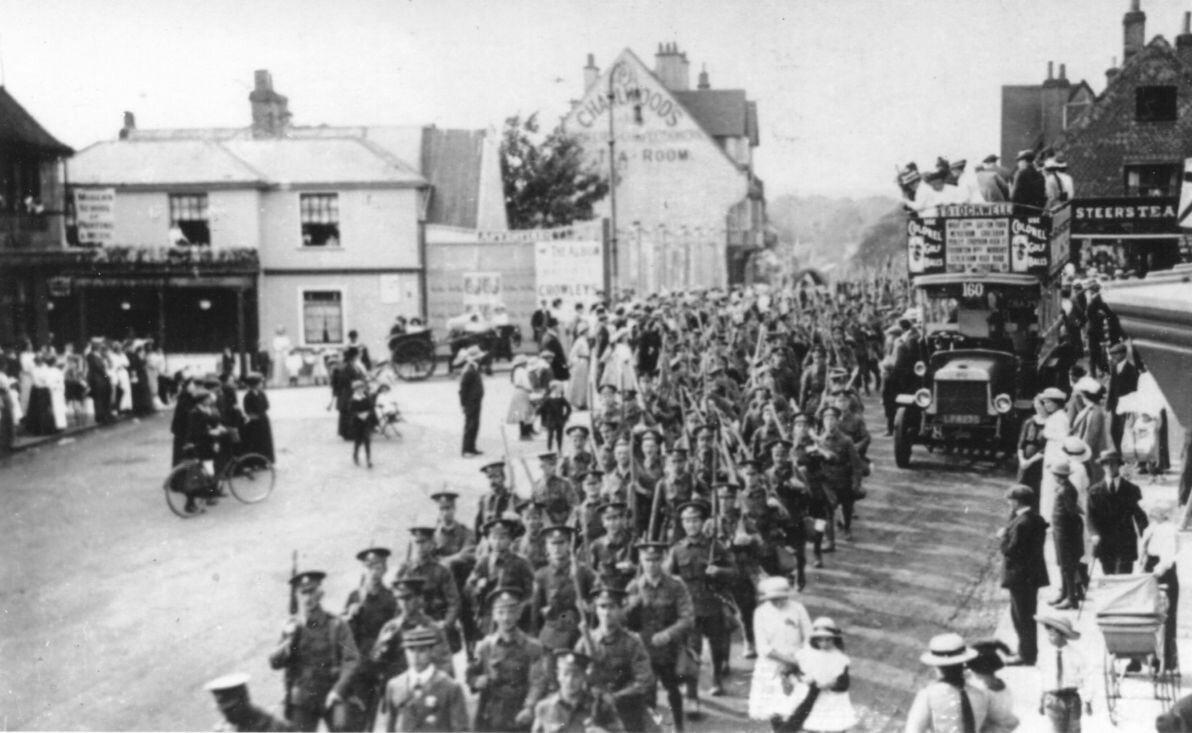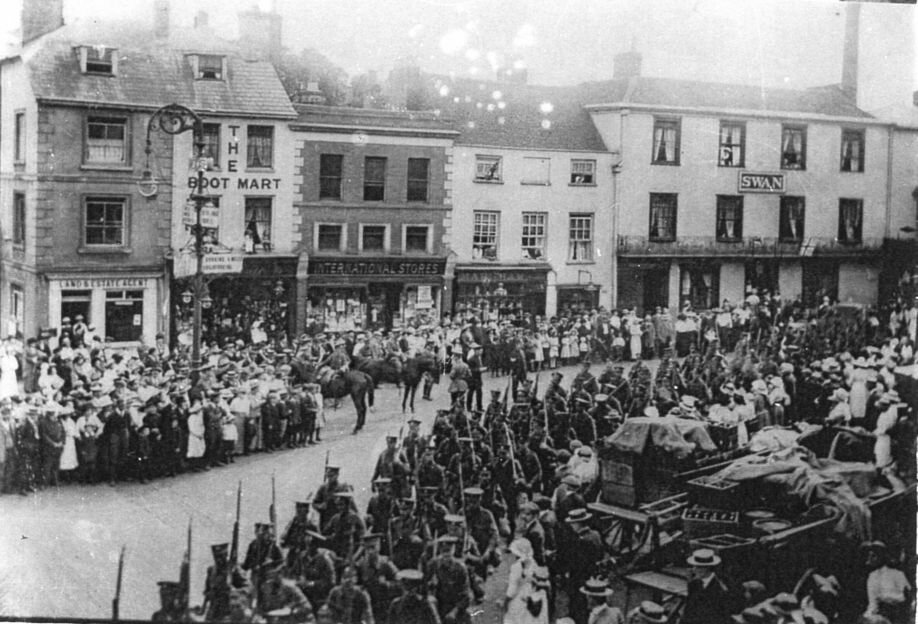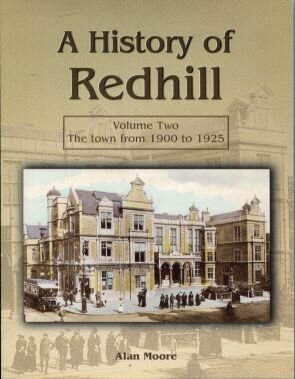Reigate History
Reigate & Redhill DVDs and associated local history
1st WORLD WAR
based on the book, A History of Redhill, Volume 2 by Alan Moore
The Outset of War
At the outset of war rumours circulated about foreigners living in the Reigate/Redhill area. Some of these foreigners were Germans and Austrians. Speculation was rife that those living on high ground had concrete structures beneath their lawns ready for gun emplacements for use by an invader. The police visited all those of foreign descent and made full enquiries. Some of them had been born in England and some had been naturalised long before the war. None had strategic anti-British installations.
Preparations for War
Preparations for war at home immediately affected the Reigate reserve men of the 5th Battlion of the Queen’s Royal West Surrey Regiment. They had begun their annual training only a week before war broke out and found they had to return home immediately. Arriving in Reigate at 10pm all they had time for was a night’s sleep before reporting to Reigate Drill Hall the next morning.

Women grouped around the Drill Hall door from 2pm. Just before 4pm the Mayor and Mayoress arrived and a lone bugle sounded and the men filed out to march to the railway station via Lesbourne Road, Bell Street and Market Square, through the tunnel and up London Road to the station. After a few choruses of popular songs a train from Guildford bore them away. War had come to the Borough of Reigate.

A column of troops from London marched into Reigate on Tuesday, 8th September 1914. Large crowds welcomed them and they were met by Scouts and the Boys Brigade who showed them to their billets. Places chosen for the men included church premises in Nutley Lane and the Reigate Lodge estate. Local people provided meals, blankets and mattresses.
Recruitment, Kitchener’s Army and The Roll of Honour
The Market Hall, Redhill was used as a recruiting station and in Reigate the old Gas company offices were used.
Because of recruitment difficulties the Roll of Honour was introduced across various parishes of the Borough. A large crowd gathered outside the Market Hall, Redhill, the Town Band played stirring music and speaker after speaker made direct appeals to young men to volunteer. There was a march from Reigate, through Meadvale, over the Common to Woodlands Road, down Brighton Road and up Station Road to Shaws Corner. The result was judged to be a good one with 584 men recruited in 10 days.
Troops Billeted in Redhill
Considerable numbers of soldiers were situated in Redhill, some in private houses, some camped on the common and other open spaces. The billeting officers came along to knock on every door and allocated men depending on the size of house and occupants. Arguments ensued. The loudest from parents with daughters, although there was no question of refusing. Payment for board and lodging was 2 shillings and 6 pence (12.5p) per day.
There were various reasons for the soldiers’ presence in town. Due to its importance as a railway junction, Redhill was made the headquarters of the troops on track and bridge guard duties in Surrey and Sussex. Others were en route, some procuring horses and some training.
Mrs Martin, a girl at the time, remembered the soldiers: “They used not horses but mules, which were very, very wild. There were four mules to a cart and I can remember the soldiers standing up in the carts driving them down the Brighton Road like mad. There were lots of runaways and I remember that we used to stand on the pavement and watch. The troops were in Redhill until the end of the war. Some of them used to go down the road singing, ‘Come and join, come and join Kitchener’s army; seven bob a week and nothing to eat.’ Wherever you looked there were great big pictures of Kitchener.”
“You saw the soldiers marching but you very seldom saw the officers. Sometimes you saw them in the carts but always standing, never sitting. My father got into conversation with the soldiers, perhaps in a pub, and we undertook to do their washing. We were supposed to darn their socks but heaven knows how they were able to walk on the darns. Sometimes the socks were so full of lice they had to go on the fire.”
“As the war went on food got tighter and tighter. We didn’t seem to be short of clothes, just food. I heard talk of merchant ships being sunk and we got less and less. Children would queue for food as soon as we heard there was some. There was a place that sold potatoes, Reddy’s, I believe and when you heard they had some in you headed there. You queued and as soon as it got to your turn that’s when there were none left. Another place we used to go was a shop called the Maypole in the High Street. It sold only margarine. Directly one person said there was something to eat in a shop you queued for it.”
“The payment for the soldiers’ washing and darning was soldiers’ rations. Their rations were stored in empty houses and I often used to see wagons draw up and sides of beef carried in. Other times we’d see the meat going out, to be cooked I assumed. Of course, there was no hygiene. I came home one day and we had stewed mutton and rice and I thought the rice was maggots because I’d seen maggots in the soldiers’ meat. My brother wouldn’t eat currants – the first time he saw them he thought they were flies, like the ones he’d seen all over the soldiers’ meat.”
Hospitals
Some hospitals were set up in private houses. In December 1914 Queen Alexandra and Princess Victoria paid a visit to the Ward Hospital at Reigate Hill. At the hospital were 16 wounded men from the British and Belgian armies. Both ladies spoke to each man, enquiring how they had got their wounds. In one case a soldier was asked if he had killed many Germas, to which he replied that he had killed a good few.
The Ward Hospital existed through the generosity of the Hon Mrs John Ward who, with her husband, accompanied the Royal ladies, giving each man a present in the shape of a cigarette or tobacco pouch, each with the recipient’s name on it.
There were several such hospitals in the Redhill/Reigate area. A 40 bed hospital in Wray Lane closed in 1918 in favour of the newly opened 50 bed Beeches Auxiliary war Hospital in Beech Road, Reigate. In 1912 an additional ward had been built at the workhouse on Redhill Common. It was meant as a hospital for the workhouse but was requisitioned by the military from May 1917 until 1919 and it was here that the wounded were brought from France, the first time that anyone other than local poor had ever been treated there.
Prisoners of War
During WW1 prisoners of war were housed in Chigwell House, London Road, Redhill. They were marched to work on farms at Merstham. They wore ankle length greatcoats with plate-sized red marks on the backs and round, pillbox-style hats. Sometimes the local children would run alongside them and, it is said, even hold their hands. After the war, when Chigwell House was empty, some Redhill boys went inside. The walls were covered in drawings, including one of the Kaiser, some had German captions. The boys found it a scary place. After the war there was a proposal it be converted into flats but this was refused. Chigwell House was demolished and replaced by the DSS offices on London Road, Redhill.
The information in this article is based on Alan Moore's book, "A History of Redhill", Volume 2 which can be purchased from Waterstones, Redhill.
If you have any information or photographs of the locality during the 1st World War, we would love to hear from you.
